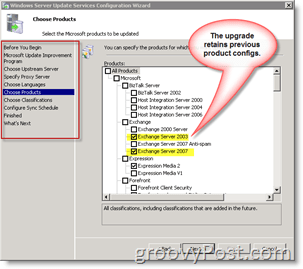The released code can be installed either as a new install or an upgrade to WSUS 3.0 SP1. The upgrade from WSUS 3.0 to WSUS 3.0 SP1 was very painless, so I decided to go ahead and upgrade my home WSUS server to SP2, skipping the testing I would usually go through. This shortcut will be an excellent test before I look at upgrade work tomorrow.
WSUS 3.0 SP2 Release
The release notes appear to add some nice new features to the Free Microsoft Patching Service, specifically support for their new OS’s Windows Server 2008 R2 and Windows 7: Ok. Looks good. Let’s get move forward with the upgrade: New Windows Server and client version support
Integration with Windows Server 2008 R2Support for the BranchCache feature on Windows Server 2008 R2Support for Windows 7 and Windows Server 2008 R2 clientsCompliance Reporting WSUS feature improvements Auto-Approval Rules: Auto-approval rules now include the ability to specify the approval deadline date and time for all computers or specific computer groups.Update Files and Languages: Improved handling of language selection for downstream servers includes a new warning dialog that appears when you decide to download updates only for specified languages.Easy Upgrade: WSUS 3.0 SP2 can be installed as an in-place upgrade from earlier versions of WSUS and preserves all settings and approvals. The user interface is compatible between WSUS 3.0 SP1 and SP2 on the client and the server.Reports: New Update and Computer Status reports let you filter on updates that are approved for installation. You can run these reports from the WSUS console or use the API to incorporate this functionality into your own reports. Software updatesStability and reliability fixes are included for the WSUS server, such as support for IPV6 addresses that are longer than 40 characters.The approval dialog now sorts computer groups alphabetically by group name.Computer status report sorting icons are now functional in x64 environments.A new release of Windows Update Agent is included with WSUS 3.0 SP2 that provides improvements and fixes, such as support for APIs called by nonlocal system callers in a non-interactive session.
The first and only issue I ran into during the install was the Installer complaining that I didn’t have the Microsoft Report Viewer Redistributable 2008 Installed – Download Link. The installer told me I could complete the install of the Report Viewer after WSUS 3.0 SP2 completed the install (which I did.) After that, the Upgrade from WSUS 3.0 SP1 to SP2 was as simple as Next, Next, Next…
Following the initial install, go through the remainder of the install/upgrade by the WSUS Config. Wizard. Settings such as Upstream Server, Proxy Server, and Patch Languages are configured here.
Once the install was completed, I was pleasantly surprised to see that the upgrade truly was an in-place upgrade. After the upgrade, I launched the WSUS Admin Console and found all prior patch approvals, servers, workstations, etc., were still intact, just like I left them before the upgrade.
Regarding the Admin Console, it looks like no significant or even noticeable changes to the GUI. Everything was in the same place, no big changes. As I dig in, I’ll post any additional findings. WSUS 3.0 SP2 can be installed alone, or as an upgrade of WSUS 3.0 SP1. The way I read that, you must be at SP1 prior to SP2. That being said…. I would try it anyway. The installer appears to do a good job of scanning for pre-req’s so the worst case is it will tell you “Sorry, you need SP1”. Another option is to just apply SP1 then apply SP2. It might be an extra step and take an extra 30 minutes but if you don’t have a test environment and you don’t want to screw up production, that would be the safer path probably. how to change windows 7 update path to local WSUS? Any ideas? Comment Name * Email *
Δ Save my name and email and send me emails as new comments are made to this post.
![]()




